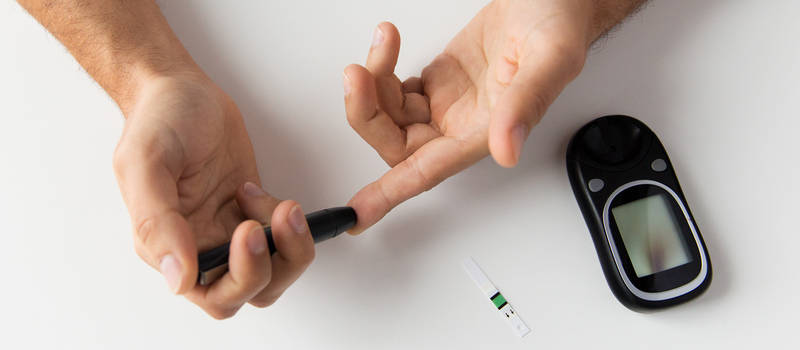Type 1 diabetes, also called juvenile diabetes or T1D, is a permanent, pancreatic condition where very little or no insulin is produced. While the greatest number of cases begin between the ages of six and eighteen, adolescents are susceptible as early as birth. As a direct result, buying life insurance for type 1 diabetics becomes a challenge.
Life Insurance for Type 1 Diabetics: A Guide To Securing Coverage

Because type 1 diabetes will likely affect overall lifespan, life insurance companies are forced to assess the amount of risk a person has, and adjust their premiums accordingly. For diabetics, this means higher costs.
Life insurance for diabetics can be as much as 3-5x more than someone without it.
The cause of type 1 diabetes is still unknown, and there is no cure. These are factors which insurers must consider.
Even with proper diet, exercise and maintenance (usually through prescriptions), the long term effects of type 1 diabetes only makes it more difficult to get approved for a life insurance policy. Whether it’s an acute event, like diabetic ketoacidosis (DKA), or something chronic like heart disease, diabetic retinopathy, or renal failure, complications do arise.
This is the primary reason we suggest securing coverage sooner than later. Additional medical concerns like these will only further escalate prices.
What You Need To Know To Buy Life Insurance As A Type 1 Diabetic
Searching for life insurance can be a daunting process, especially if you have a chronic condition like type 1 diabetes.
But, while people with diabetes may face higher life insurance premium rates and a steeper hill to climb for approval, there is coverage available out there which will help protect your family’s future. Armed with knowledge, you can increase your chances of finding the perfect life insurance policy for you.
A Type 1 Overview (And Why It Impacts Approval Odds)
Type 1 diabetes, sometimes called juvenile diabetes, is typically diagnosed during childhood and is a condition which will have to managed throughout the patient’s life. For this reason, it can present a challenging barrier when it comes to getting a life insurance policy.
About 5% of all diabetes patients have type 1 diabetes, accounting for more than a million people in the US, around 200,000 of whom are children. And each year, these numbers grow, with around 40,000 new diagnoses of type 1 diabetes annually.
In type 1 diabetes, the body does not produce insulin, a hormone responsible for the regulation of glucose, or sugar, in the blood.
This is different from type 2 diabetes, which is usually diagnosed later in life. In type 2 cases, the body still produces insulin, but either becomes resistant to it or doesn’t produce it at high enough levels.
Although people with type 2 diabetes will face some similar barriers to finding life insurance as type 1 diabetics, the fact that their condition doesn’t typically begin until middle age helps make the process a little easier, and typically, a little cheaper.
Because the body doesn’t produce any insulin at all in this lifelong condition, type 1 diabetes is also sometimes called insulin-dependent diabetes. Type 1 patients will have to take insulin to help their bodies regulate their blood sugar throughout their lives.
With proper insulin intake, blood sugar monitoring, exercise, diet, and care executed in partnership with doctors, type 1 diabetics can manage their condition and live healthy lives.
However, serious complications can occur, especially if the disease is not properly managed.
These complications include nerve damage, kidney damage, and problems with vision. Type 1 diabetes can also lead to complications during pregnancy and issues with the cardiovascular system, including an increased risk for coronary artery disease.
Why Shop for Life Insurance?
Life insurance is a smart way to help protect your family in the event of your death. While it is a smart move for anyone, it can be especially important for people dealing with a chronic condition.
To obtain life insurance, you will pay a monthly or annual premium, just like you do for your car insurance and health insurance.
Life insurance policies may cover a specific term (like 20 years) or they may cover you throughout your life. Regardless, if you do pass away while you have coverage, your chosen beneficiaries will receive a predetermined payout.
This payout is a set number decided on at the time of your enrollment in a plan. To determine how much coverage you will need (i.e., how much of a payout your beneficiaries will receive) you will want to consider the situation your family will be in if you were to pass.
Considering your family’s needs is important for many reasons. Life insurance is especially critical if your family depends on the income you earn.
For example, your family could rely on the funds from a payout instead of your regular income.
Your family can also use the money from a life insurance policy to manage things like funeral costs or outstanding debts. But perhaps most importantly to people with a chronic condition, life insurance payouts can help cover any remaining medical bills or hospital debts which are still owed after you pass.
Because medical expenses can sometimes be quite high for people with diabetes, especially if complications develop or the disease is not well managed, life insurance can help prevent your family from being burdened with your medical expenses.
For this reason, life insurance has another major benefit; giving you significant peace of mind. Knowing your family will be financially taken care of, no matter what the future holds, can represent a huge weight lifted off your shoulders.
What to Expect
Because type 1 diabetes can cause serious health problems, and it is a lifelong condition that spans from childhood onward, insuring someone with type 1 diabetes might be a high risk venture for insurance companies.
If you are a type 1 diabetic seeking a life insurance plan, it is wise to be prepared and organized as you begin the process.
You will have to provide detailed information on your medical history, diabetes management plan and management history, overall health, and other health problems or conditions. Your medical records will be reviewed by the insurance companies you apply for coverage.
In most cases, you will have to undergo a physical exam. This exam will help the insurance company determine and confirm some of the topics and factors we’ll discuss below.
Major Factors Considered
When you apply for a life insurance policy, there will be many factors that the insurance company will consider. By considering these factors yourself before applying, you can potentially increase your chance of approval.
- Presence and type of complications
- Frequency of doctor visits
- Age at diagnosis
- Blood sugar levels
- History of blood sugar management
- Previous hospitalizations related to diabetes
- Overall health, including factors like weight and smoking status
- Type and dosage of insulin and other medications
- History of taking prescribed medications
The above issues were fairly diabetic-focused and generally health related. However, there are other issues which might come up in every life insurance application, regardless of any medical conditions.
These factors include drinking habits, history of drunk driving offenses, risky hobbies, and occupation.
Because these factors are considered, bungee jumping stunt doubles are likely to face higher rates than stamp collecting office workers. And women, who generally have a longer life expectancy than men, usually can expect slightly lower life insurance premiums.
Some of these issues, like a history of complications or previous hospitalizations long since passed, you will not be able to change or affect.
But other factors, like seeing your doctor regularly, taking medications as prescribed, and maintaining a healthy weight, you can affect and improve upon prior to starting a life insurance application.
Insurance companies like to see a history of regular doctor’s visits, as this can indicate a well-managed condition and an active approach to your health.
Other factors like fasting blood sugar levels and A1C blood glucose levels can provide an easily quantifiable snapshot of your disease management.
Your A1C levels, which provide insight into your average blood glucose levels over the preceding months, are especially seen as providing a good overview of your diabetes management. A level of 7 or below is typically considered a sign of good management of the condition.
However, having an ideally managed case of type 1 diabetes can be a hard mark to reach.
Fact: Less than one-third of patients hit the blood glucose levels their doctors set as goals.
If you have other conditions alongside diabetes, like high blood pressure or obesity, it is wise to make sure you are also managing these conditions as best as possible.
Losing weight, if you are overweight, and getting factors like blood pressure or cholesterol under control can help lower your risk in the eyes of life insurance companies, lowering your rate in the process.
It can even be helpful if you can show a plan is in action for managing these issues, even if you haven’t reached your goal blood pressure or weight yet. Progress on the journey there will help your case and possibly help lower your monthly life insurance rates.
Life Insurance for Diabetic Children
Some parents of children with type 1 diabetes may opt to take out a life insurance policy for their child. This is often done as a preventative measure to keep their child from facing difficulties finding an insurance policy later in life.
In some cases, it can be easier (and much cheaper) to obtain life insurance policies for children, like through work, if avialable. When the child is an adult, they can then take over payments and management of the policy, adjusting it as needed.
A childhood life insurance policy may prevent the child from being denied for life insurance coverage later in life. It can also help them avoid potential struggles with finding an affordable policy which fits their needs.
However, insurance companies will still examine factors like those discussed earlier, including disease management, co-existing conditions, and hospitalization history.
Just like with adult type 1 patients, these factors can serve to make obtaining a life insurance policy more difficult or easier, depending on an individual patient’s history.
If you are considering taking out a life insurance policy for your child, you will want to consider several factors. These factors include the length of the term you will want covered, and when and how you plan to pass on the monthly payments and management of the plan to your child.
Another factor to consider is some people are able to get life insurance through their jobs, regardless of pre-existing or chronic medical conditions, a situation which might apply to your child down the road.
Pro Tip: Always make sure the policy is portable, meaning you can take it with you when you leave, if you get it through work.
This is an individual decision that you will need to weigh as a family or as a parent. Just as the insurance companies do, you will want to do your research and weigh the risks of each option.
Consider the Company Thoroughly
Some insurance companies have an automatic decline policy for conditions like type 1 diabetes. Do your research and don’t waste your time applying to these companies.
Not only is applying to these companies with an automatically-denied condition a time-waster, a history of previous declines could make finding a policy even more difficult. Because of this, you want to limit declines as much as possible.
But life insurance acceptance guidelines are not standard from company to company; in fact, they are far from it. An outright denial from one company does not mean you’ll receive an outright denial from the next.
Some companies see the condition as a huge risk, while others routinely insure people with type 1 diabetes.
Some companies might put a huge value in low A1C levels, while some might put more value in a long history of regular doctor visits and a healthy BMI. The variations are endless.
Working with us, because we know the industry, can be an invaluable help. We will likely be able to advise as to which companies are more likely to insure you, and which it might be best to skip and avoid an outright denial.
It is also important to remember life insurance options often to vary from state to state. We can assist you there, too.
Cost Expectations for Type 1 Diabetics
Once you are approved for life insurance, you can still expect to pay higher than a person without type 1 diabetes or another chronic condition.
Typically, type 1 diabetes patients have a rate which is an average of two to three times higher than peers without the condition. While it’s not always the case, it is likely.
However, a life insurance policy can mean, if something happens to you, your family won’t be left saddled with your debts, or unexpectedly without your salary, or whatever your unique case may be.
And just because your policy cost may be higher doesn’t mean it will be outrageously high or unaffordable. Many type 1 diabetics find affordable, solid life insurance plans which will help protect and provide for their families.
This peace of mind is priceless.
You may also be able to opt for a plan which does not require a medical examination. This can be a good option if, for example, you know your diabetes is not well managed or if you have a complicated medical history with many diabetic complications.
For example, you may have trouble keeping your A1C levels under level 7 and have been hospitalized several times due to issues related to diabetes. Or, maybe you have dealt with some nerve damage from your diabetes and have some other health issues like high blood pressure and obesity.
No matter what your unique situation is, a complicated medical situation or history can be a barrier to finding life insurance. But guaranteed policies, sometimes called graded life insurance, can help.
The non-medical policies are also a good option if you would like life insurance fast. Typical life insurance plans involving a detailed review of medical histories and physical exams can take quite a while to review and go into effect.
These simplified issue policies, on the other hand, can often be started online and be approved within hours or days.
While these policies can be easier to get, they come at a much higher monthly cost. Some may also have a waiting period, or period after the purchase where the policy is paid for, but not in effect yet.
This means if you were to pass during this waiting period window, your beneficiaries would not receive any money from the policy, or a lesser payment (usually stated in percentages for the first year or two).
Plus, they may have lower coverage amounts than traditional policies requiring medical exams, meaning they’d pay out less to your beneficiaries in the event of your death.
There are some negatives to these policies, but they are a good fallback option if you are having trouble getting approved for a life insurance policy.
Putting a Good Foot Forward
One of the best ways to find the best life insurance policy for your individual situation, medical history, and familial needs is to work with an experienced professional whocan help you navigate the system.
This is what we do.
And, remember, some of the best advice for shopping for life insurance with type 1 diabetes is also just good advice for living a healthy life.
- Manage your condition as best as possible and aim for the blood sugar target levels set by your doctor.
- Be proactive with your doctors and your health, visiting them regularly and taking all medications as prescribed.
- Play an active role in your condition management.
You should also make efforts to stay fit and active and eat a healthy, balanced diet. And if you’re a smoker, you should try your hardest to kick the habit.
Smoking will automatically increase your life insurance rates and put you at risk for a whole host of major health concerns.
Making a concerted effort to address all of these topics will help lower the perceived risk you pose to the insurance company, and thus will help lower the likelihood you will be faced with an extremely high monthly premium or a flat-out denial.
Plus, these efforts will all help you live a healthier life! Like life insurance, living more healthfully is another way to help care for your family.








